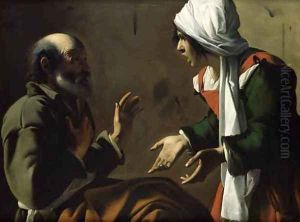Saraceni Pensionante de Paintings
Carlo Saraceni, often referred to as 'Pensionante de Saraceni' due to a misinterpretation of his relationship with a Roman hostelry, was an Italian painter of the Baroque era. Born in Venice in 1579, Saraceni is known for his pivotal role in introducing early Baroque painting to Venice, a city that was initially resistant to the new style that was flourishing in Rome.
Saraceni likely trained in Venice, though detailed records of his early education in art are scarce. He moved to Rome around the turn of the century, where he became deeply influenced by the works of Caravaggio, whose revolutionary use of chiaroscuro and dramatic realism was transforming the art scene. Saraceni's works are often noted for their Caravaggesque qualities, incorporating the master's trademark use of stark lighting contrasts and naturalistic detail, yet they also retain a certain lyrical quality that is characteristic of Venetian painting.
In Rome, Saraceni quickly absorbed the prevailing Baroque aesthetic and started receiving commissions. His works include religious subjects, mythological scenes, and portraits. He painted for various churches and private patrons, and his paintings often depict scenes with an emotional intensity and a focus on human experience. Some of his notable works include 'The Martyrdom of Saint Cecilia', 'The Madonna and Child with Saints', and 'Saint Anne, the Virgin, and the Christ Child'.
Despite his success in Rome, Saraceni's career was cut short when he returned to Venice in 1619. He died there a year later in 1620, likely in his early forties. His works, however, continued to influence other artists, and he is remembered for his role in the cross-fertilization of Venetian and Roman artistic styles. Although not as widely known as some of his contemporaries, Saraceni's contribution to the development of Baroque art is significant. His paintings can be found in various museums and collections around the world, attesting to his enduring legacy.

